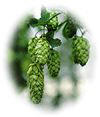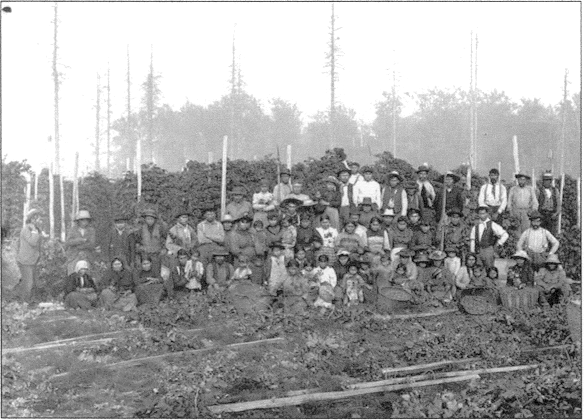
Hops

Those who do not know the hop can picture an ordinary vine hung profusely with clusters of leafy berries.
-Daily Colonist, Oct 7, 1928
Hops in brewing
Since the early days of brewing, herbs have been used as a flavouring agent in beer. In the 17th and 18th Centuries, mercantilism in Europe created a new merchant class that was anxious to sell their goods to a wider audience. Mercantilism meant greater access to new commodities and information and brewers worked together to improve their products. The use of hops as a flavouring agent increased at this time, due in large part to its preservative qualities. The bitter taste of hopped beer eventually won people over and it became an essential ingredient in brewing (Evans, 1991, 3).
Hops on the Island
In the 1860's, local brewers began to import hops from the United States because no local product was available. In 1863, over $50,000 worth of hops was imported from San Francisco for use in Victoria breweries (Evans 1997, 2). The prohibitive cost of importation led local brewers Arthur Bunster and Alfred Elliot to offer prizes to farmers for producing successful commercial crops. The Daily Colonist backed the idea, stating that:
There is nothing to prevent the culture of hops here. We possess the climate and the soil, and we have in our population experienced hop growers
-Daily Times, March 9, 1863
Several farmers, including William Towner, took up the request and began cultivation in the 1870's. By 1876, farms had been established in North and South Saanich, Sooke, and Metchosin (Daily Colonist, Oct 7, 1928). In this decade, farmers produced 90-1000 lbs of hops per acre and the hops sold for $1.25/lb (Evans 1997, 2). The quality of Vancouver Island hops was praised by brewers from across Canada. Thomas Haliday of Guelph, Ontario, was won over by the product:
I stared brewing at the age of fourteen in England and have followed the business ever since, handling hops from nearly every country in the world, and the 'Pacifics' grown in Saanich are equal to any I have ever brewed. After the third year of their use my business increased fifty percent.
-Daily Colonist, Oct 7, 1928
As a commercial crop, hops fared better than barley on Vancouver Island. By the 1870's and 1880's local hop farmers were doing well enough to supply the local market and to export their product to America and Europe. Local brewers had no problem securing hops, in fact, the Victoria Brewery received all of their hops from only one source, the Towner farm (Daily Colonist, Oct. 7, 1929).
The success of hop farming on Vancouver Island lasted throughout the nineteenth Century largely because crop failure in Britain and the United States meant that there was a ready market outside of Victoria (Daily Colonist. Oct 7, 1929). By the turn of the century, crops in the United States improved and the United States placed a duty on hops, making it twice as expensive for American brewers to buy Canadian hops. Also at this time, the hop industry on the mainland of British Columbia was becoming a major competitor to the Island industry. Many hop farmers on Vancouver Island went out of business as these larger operations took over the North American market (Daily Colonist, Oct 7, 1929).
Hop Picking
Hops are harvested in early September in an intense one month period. Large numbers of hop pickers are required to complete the job in this short time frame; up to 200 harvesters could be employed at once, costing the farmer up to $2000 per day. On Vancouver Island, native people from Saanich and Metchosin made up much of the workforce (Daily Colonist, Oct. 7, 1929). Being such a short harvest period, the hop harvest fit in with the seasonal cycle of the native people. Because hops are very light and much of the work was not strenuous, all members of the native community were able to help with the harvest.
Hop picking provided an economic boost that was much needed at a time when other traditional activities like fishing were restricted by the government (Iredale). Hop picking also became an important social event after the ban of the potlatch in 1884. The gathering of all members of the community in the hop fields became a social, ceremonial and economic gathering, much like a potlatch (Carlson).

Courtesy Chilliwack L. O. Booen, photographer P1622